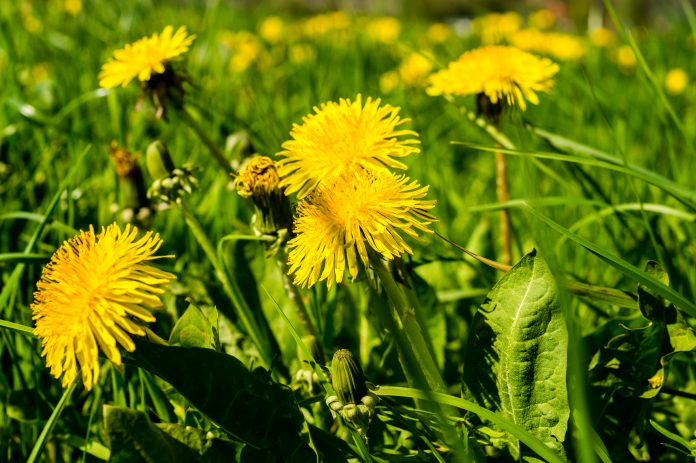
Those Glorious Dandelions! Taraxacum officinale (composite family). Spring is coming! Starting about this time each year I find myself craving sour tastes. My body is longing to cleanse itself of toxins accumulated over a long winter of holiday indulgence, rich foods and various colds & flus. I am conscious of a general stagnation of energy in the digestion, liver and kidneys.
Dandelion
I’m always so amazed at how much better I feel when I begin using dandelion in the spring! All that stagnated liver/kidney/stomach energy lifts and I feel revived! This craving for sour flavors always has me out hunting for all those youthful green dandelion leaves popping up everywhere about today. I eat them fresh in salads or just munch on them through the day. I also strain and bottle the dandelion root tincture which I set up in the late autumn.
This common “weed” of the composite family is a potent restorative to the liver. It’s also full of minerals such as calcium, iron, magnesium, manganese, phosphorous, potassium, selenium and zinc, in addition to vitamins B1, B2, B3,and C. Ounce for ounce, dandelion contains more carotene than carrots.
Dandelion Benefits
Dandelion leaves act as a diuretic to help cleanse the bladder and urinary tract. They help alleviate water retention associated with PMS.
Dandelion also cleanses the blood and liver, and increases bile production. It reduces serum cholesterol and uric acid levels and enhances the functioning of the pancreas, kidneys, spleen, and gut.
Toning the liver and kidneys is one of the greatest things we could do for our general health. Especially women! A strong, healthy liver will enable us to process and excrete hormones. Additionally, it is vital for a healthy immune system.
How To Use It?
All parts of the dandelion plants are usable, but they have different properties and must be harvested at the right times.
Young Leaves have tonic properties and are chosen in the spring and eaten raw in salads. If you find the taste too bitter attempt chopping them as good as possible and mixing them with other uncooked greens.
Mature Leaves have strong diuretic properties. They’re chosen in early summer before the plant flowers. These are the leaves I harvest and dry for tea. They can also be made into tinctures. These stunning, dark green leaves are loaded with vitamins and minerals!
When choosing dandelion leaves, search for dark green, smoothe leaves (dandelion leaves aren’t fuzzy.) Avoid picking under powerlines or near streets.
Dandelion Juice
Pick a colander filled with dandelion leaves and rinse them very well under cool water. Run them through the juicer with 1/2 an apple. This will make a wonderful shot glass filled with delicious, nutritious juice. You will feel a great little zing with this beautiful tonic!
Dandelion Roots
Dandelion roots act as a blood purifier which helps the kidneys and liver to eliminate toxins and poisons in the blood. They act as a mild laxative and also help improve digestion. The roots are also beneficial for skin conditions such as boils, abscesses and psoriasis. They’ve been used for centuries to boost jaundice. Ideally, you need to use the origins of two year old plants. In the late autumn the roots will include the maximum concentration of inulin. Dig the entire plant up and hang upside down to dry in a cool, dark location. The roots grow very long, so dig deep! The fresh or dried roots can be used to make tinctures. Dried roots can be powdered for capsules or used in infusions.
Dandelion Flowers
For a tasty, easy-to-make tonic wine try this:
Pick dandelion flowers on a warm, dry day.
Macerate 1 cup (60 g) flowers and steep in 4 cups (1 liter) white wine for 1 month in an airtight container. Strain out the flowers and sweeten to taste with just a little bit of honey if desired.





